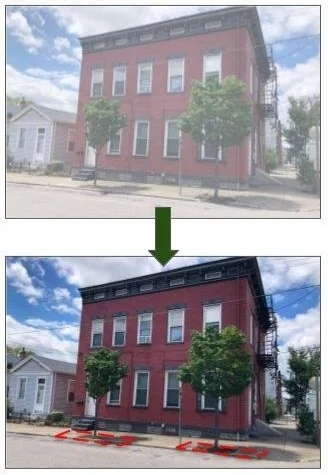
Improving Health in West Newport with Trees
UPCOMING EVENTS
Press Event - Aug. 22nd
Come hear about the program and help us celebrate the official project launch - 10am in the multi-purpose room at the city building.
Fall 2024 Planting Event - Oct. 19th
Planting planned for October 19, 10am at the intermediate school. More details to follow.
HOW TO SIGN UP
If you’re in the project area (shown in gray in the map below), you are eligible to participate in this free program.
Just fill out this application!
This map was created based on federally-set variables to identify environmental justice areas. These include levels of air pollution, poverty, costs of housing and energy, and lack of access to green space.
Details to Note
Sidewalk must be wide enough to allow for at least 4’ sidewalk and 4’ of tree well. Locations directly on top of water lines and other utilities are not eligible.
The project covers removal of concrete, filling area with soil, and planting a tree. Adjacent homeowner will be responsible for watering the first 1-2 years as well as ongoing weed maintenance in the tree well. The City will take care of any tree pruning in future years as the need arises.
Addressing Environmental Justice in West Newport
The amount of trees (also known as tree canopy) varies greatly across Newport’s neighborhoods. Data shows that the western areas of Newport experience higher levels of heat stress and poor air quality compared to other part of the city. This is directly connected to the fact that only 10-12% of this area is covered by tree canopy, compared to 24-54% in other Newport neighborhoods. Low tree canopy cover also creates other disadvantages as well, including higher energy bills, lower life expectancy, and more.
This area of low canopy is located in an area where many residents are lacking resources to deal with these stressors. This is an environmental justice issue, and one that a new federal grant recently awarded to the community will work to address.
Three organizations teamed up to apply for a federal grant to address this “inequity” in tree canopy cover in Newport - the City of Newport, ReNewport, and the West Side Citizens Coalition.
Just under $1 million in match-free funds was awarded to address the inequities in tree canopy in Newport. These funds come from the Inflation Reduction Act and the USDA Forest Service in partnership with the Arbor Day Foundation. The USDA and the Arbor Day Foundation are equal opportunity providers and employers.
The Work
Funds will be used to create space for 1,000 trees along west Newport’s public streets and parks. This will include two primary types of work - creating new tree planting areas in sidewalks (called tree wells), and expand existing sites to ensure trees in place already live longer. Once planted, all you’ll need to do is water and weed around the tree, while the City will take care of pruning when needed.
If you have any questions about this project, want to join our mailing list, or know an organization that may want to help find and coordinate tree planting sites, email us at info@renewportky.com
Trees play a critical role in the community by providing:
Expanding Existing Tree Wells
Lower Heat: Trees significantly reduce heat levels, which is a big factor in human health. They also lower energy bills (AC), which is especially important in low income areas This is critical to Newport as the climate continues to warm.
Cleaner Air: Trees filter out pollutants (dust, soot, chemicals) from the air which has significant health impacts, including lower rates of asthma.
Reductions in Flooding, Cleaner Water: Trees absorb and slow down rainwater runoff, reducing flooding during and after storms. They also clean rainwater, resulting in cleaner water flowing into the Licking and Ohio Rivers.
Better Business: Business districts with trees are shown to be more successful than those without. People are willing to spend 12% more and shop longer in areas with trees.
Better Health: Trees have a significant impact on human health:
Heat reduction is a key role for trees in cities. More people die from heat related deaths over all other natural disasters combined.
Trees have an impact on mental health, including less anxiety and depression, and positively impacts those with ADHD or autism.
Higher canopy coverage results in more and better quality sleep.
Spending more time in places with trees increased academic success and creativity.
Populations living in areas with higher tree canopy saw better birthweights and fewer preterm births.
Trees are associated with huge reductions in incidences of respiratory and cardiovascular disease, with health benefits across the United States valued at $6.8 billion for a single year.
Removing Carbon: Trees absorb carbon from the air, helping slow climate change events.
Less Crime: Areas with more trees have shown reductions in crime.
Less Noise: A 100-ft wide tree buffer can cut noise from nearby highways significantly.
Wildlife Habitat: More trees means more wildlife - with increased tree density, even rare birds of prey may come to city spaces and provide more opportunities for learning. Additionally, Many tree species, like lindens (Tilia) and black gums (also called “tupelo,” Nyssa), which you can find planted along some of our city streets, are important food sources for our pollinators.
Creating New Tree Wells



